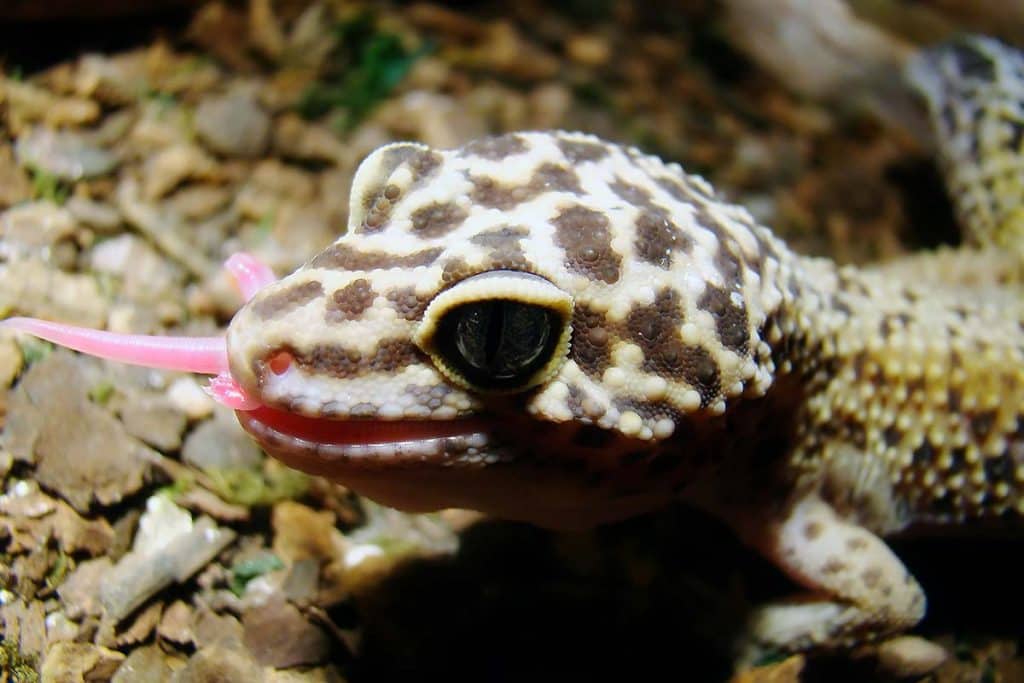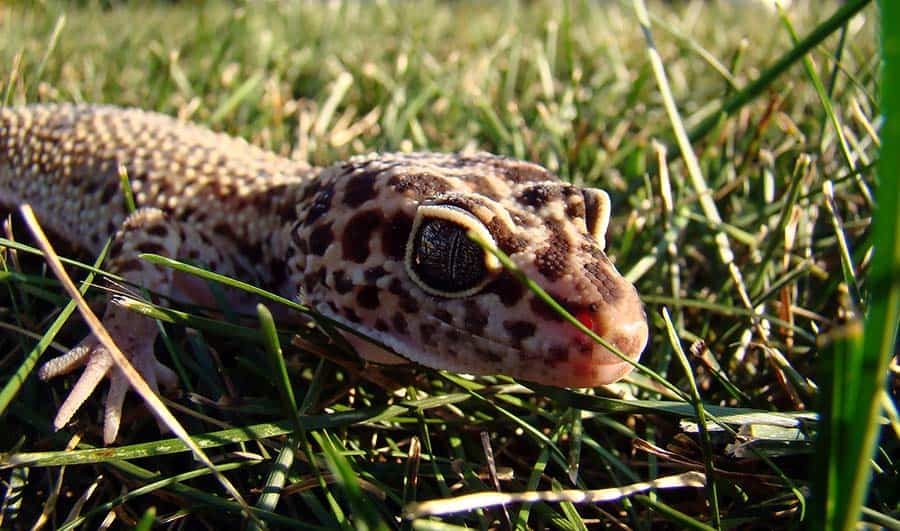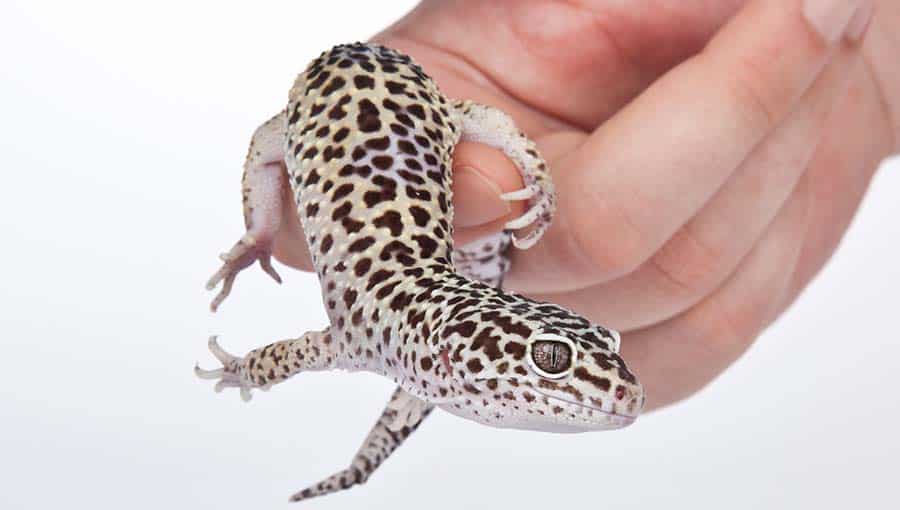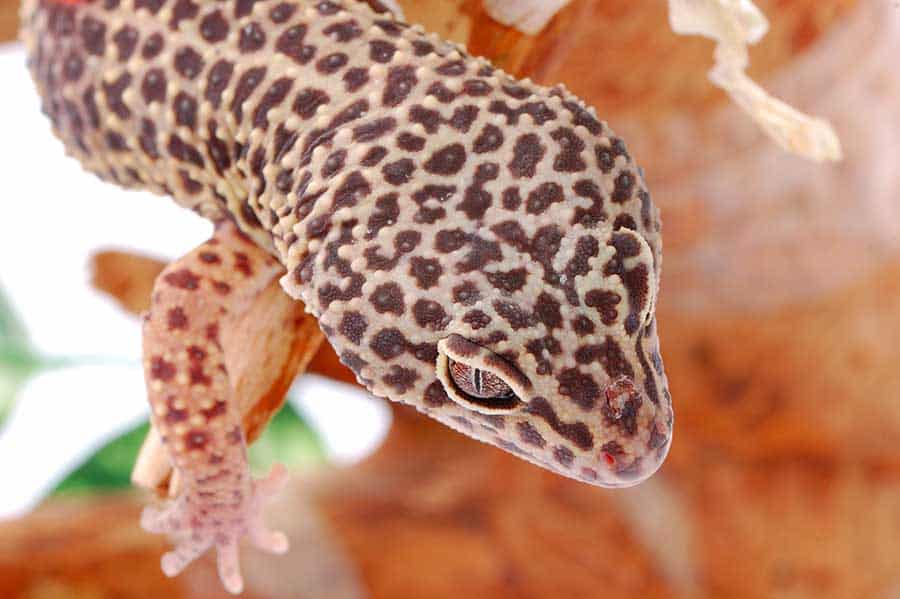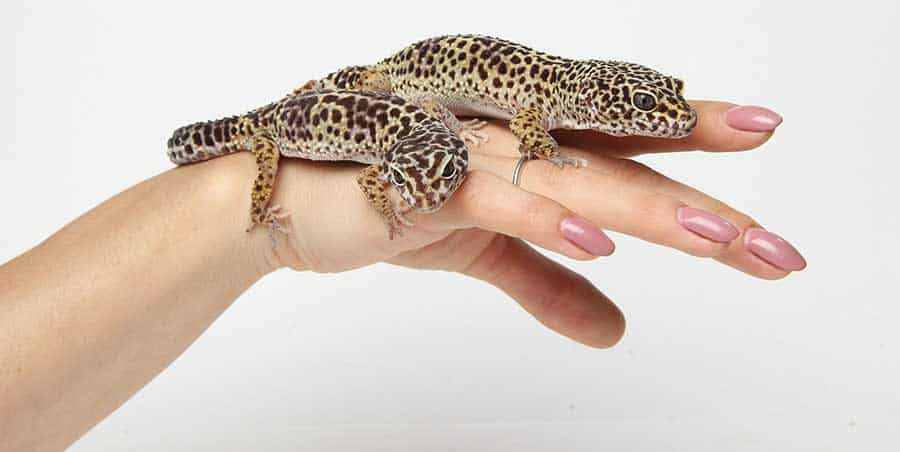It’s virtually impossible to tell the difference between a leopard gecko male vs. a female if you don’t know what to look for! However, knowing the sex of your pet reptile is very important, especially if you want to maintain a peaceful habitat. While female leopard geckos can live harmoniously in the same tank, two males would battle for supremacy.
If you’ve got your leopard gecko from a reputable breeder, chances are, the breeder has already told you the sex of your pet reptile. A male and female leopard gecko incubate at different temperatures while they are in eggs, so any reputable breeder can tell the sex of their leopard geckos right away.
If you don’t have this information, there are other ways you can sex a leopard gecko to see whether your new pet is a boy or a girl. Sexing leopard geckos is hard, but not impossible once you know where to look and what to look for!
Keep on reading to learn the main differences between the two sexes and how to tell if a leopard gecko is a male or female!
The Main Difference Between Male vs Female Leopard Geckos
The main differences between female vs. male leopard geckos are:
- Preanal Pores: Male leopard geckos have a distinct and clearly visible V-shaped row of preanal pores in front of their cloaca, whereas female geckos have barely visible preanal pores.
- Hemipenal Bulges: Male leopard geckos have two distinctive bulges on both sides of the base of their tail, behind the cloaca, whereas female leopard geckos don’t have them.
- Femoral Pores: Male geckos have enlarged femoral pores on the underside of their hind legs on their inner thighs, whereas a female leopard gecko’s femoral pores are very small and harder to see.
I’ll go into more detail about these female vs. male leopard gecko differences in the following sections!
Incubation Temp: A Sex Determinant
Whether you knew it or not, the sex of your pet leopard gecko is influenced by the incubation temperature while they were in the egg. If you don’t know the exact incubation temperature of your gecko, you’ll have to focus on finding specific physical traits.
Determining the leopard gecko’s sex is virtually impossible while they are hatchlings unless you are an experienced keeper.
Generally speaking, experienced keepers can sex their leopard geckos once they are around three or four months old. If you don’t have experience sexing geckos, you’ll have to wait until your pet is at least six months old before trying to determine their sex.
Leopard geckos reach sexual maturity when they are roughly 10 months old, at which time it becomes much easier to tell males and females apart. If the suspense is killing you and you just have to know the sex of your pet reptile, there are several ways to spot the difference.
How to Tell If a Leopard Gecko Is Male or Female: 4 Ways
Sexing a leopard gecko is not a small feat, and it is no less challenging than sexing male vs female bearded dragons. However, picking up and handling a gecko can be an even more difficult task than telling its sex. Geckos tend to drop their tails when they are scared or feel threatened, and this can happen if your pet gecko isn’t used to being picked up and handled.
Tail dropping is a defensive tactic where a gecko will cast off its tail to increase the chance of escape. While it is a clever defense mechanism, this behavior exposes a leopard gecko to all sorts of infections until its tail regrows. To prevent your pet from casting off its tail out of fear, make sure they are relaxed and comfortable before you attempt to pick them up.
To get your leopard gecko prepared for being handled, place your hand at the bottom of their enclosure. Use your other hand to slowly corral your leopard gecko into climbing into your hand. Once your gecko is safely in your hand, hold them securely but not too tightly and give them a few minutes to get used to being picked up before you start poking around.
Be sure to always approach your gecko from the side rather than from above, as they will think you are a predator trying to eat them if you hover overhead.
The best way to figure out whether your leopard gecko is male or female is to look for the following features.
1. Hemipenal Bulges
Male leopard geckos have two distinctive bumps at the base of their tails, behind their vents. Hemipenes are sexual organs that become clearly visible as soon as a male leopard gecko reaches sexual maturity.
These bulges conceal the hemipenes until the male gecko is ready to mate with a female, at which point they pop out on either side of the vent. While these nubs aren’t extremely large, they are noticeable. Since female leopard geckos don’t have hemipenal bulges, this is a great way to determine whether your pet gecko is a male or a female.
2. Preanal Pores
As I mentioned above, both male and female leopard geckos have preanal pores. However, while the male’s pores are prominent and visible, the female’s preanal pores are essentially invisible.
If you’re wondering how to sex a leopard gecko, look for a pronounced V-shaped row of preanal pores in front of their cloaca. As male geckos mature, these round pores become blatant and eject a waxy substance that contains pheromones.
Male leopard geckos rub this substance on the areas they walk to mark their territory and tell other males to back off. Exuding pheromones also help male geckos to court females and get them to mate.
A female leopard gecko will also have preanal pores, but they will be faded and barely visible. Unlike males, females don’t excrete the waxy substance full of pheromones.
3. Femoral Pores
Like preanal pores, the femoral pores will only be visible in male leopard geckos. Male geckos have enlarged femoral pores on the underside of their thighs. Femoral pores form a straight line on each thigh and look a lot like a row of white or tan dots. Observing femoral and preanal pores is the easiest in adult leopard geckos and is a great way to tell if your gecko is a male.
Female leopard geckos also have femoral pores. However, they are significantly smaller and more difficult to see than those in male leopard geckos.
4. Other Physical Differences
Like many other reptiles, male leopard geckos are typically larger than females. Males also have broader heads and are overall stockier than females. However, before they are fully grown, you may have a hard time spotting a substantial size difference between male vs. female leopard geckos.
If you check your pet gecko’s hind legs, you may notice small spurs that look a lot like tiny thorns. These are called cloacal spurs and are visible in both sexes. However, male leopard geckos usually have noticeably larger cloacal spurs than female geckos.
With that being said, you should be careful when observing these physical differences to sex your leopard gecko. Other methods outlined above are much more reliable to tell the difference between female vs. male leopard geckos.
When to Sex Your Leopard Geckos
Young geckos are very small, and both males and females look the same until they have grown up a bit.
Leopard geckos need to be larger than 5 inches in length in order to accurately sex them. Before this age, males might not present with the typical signs that indicate they are male, and you may mistake them as females.
If you get your leopard gecko from a reputable breeder, then they can tell you immediately what sex your leopard gecko is from the time it hatches.
This is because leopard geckos are temperature-sex determinated. This just means the temperature at which the eggs were incubated at will determine what sex the leopard gecko is!
- Female leopard geckos are incubated at a lower temperature: around 80°F.
- Male leopard geckos are incubated at a high temperature: around 87°F.
The Importance of Sexing Leopard Geckos
It is important to know the sex of your gecko for a number of reasons. After all, the sex of your gecko will determine certain care requirements, so you’ll need to know it at some point. The sooner you know, the better! Here’s why you should prioritize finding out your gecko’s sex as early as possible (but not too early).
1. Prevent Fights
The main reason why you should know your gecko’s sex definitively is that males are very territorial and will fight each other if they are put in the same tank. This fighting is often fatal for the less dominant leo. Many reptile owners own more than one gecko and choose to cohabitate them, but there are many precautions you’ll need to take if you want to do this.
If two males are in a tank together, the more dominant one will bully the less dominant one. The bullied leopard gecko can and will suffer from stress and injuries that may cause it to die.
2. Avoid Unplanned Pregnancy!
Another reason for finding out if your geckos are male or female is breeding! If you are planning to breed your leopard geckos, then obviously, you will want to know who is who in the enclosure! This is especially important if you are not planning on breeding.
You would not want to wake up one day and see a clutch of eggs in the enclosure and have no idea how to take care of them or not have the finances to do so!
3. Watch Out for Mystery Eggs
Reptiles and birds are quite unique in that some species’ females can and will lay eggs without ever being in contact with males!
Thankfully, this will not result in babies because the eggs are not fertilized. However, the process of making the eggs will take a huge toll on the female’s health. She will need extra nutritional care in the form of
Therefore, it is important to know who your females are so you can watch out for these mystery eggs and provide your gecko with a nutritional boost so as to not shorten their lifespan.
Read our article dedicated to the lifespan of geckos.
Tips for Handling a Leopard Gecko During Sexing
Handling in general can be stressful for leopard geckos. You do not want to stress them out even more by trying to determine their sex while handling them incorrectly.
There are two main ways you can handle your gecko while trying to figure out their sex: holding them directly in your hands or keeping them restrained in a container. Below are some tips for both methods.
Holding Your Gecko in Your Hands
Handle your leopard gecko for a couple of minutes so they are used to being out and about and have settled down. Then place their upper body between your forefinger and thumb while supporting their backs with the rest of your hand.
Gently hold them up and turn them slightly upside down so you can get a good look at their bodies. If they really start struggling, do not squeeze them! Squeezing is a sure fire way to get them to drop their tails and make them even more upset.
Let them move around freely, and once they calm down again, try to have another look. Keep your movements slow and gentle.
Keeping Your Gecko in a Container
If you absolutely cannot get your gecko to lie still for a minute or you are new to handling leopard geckos and feel a bit nervous, then there is another simple way to do it!
Place your leopard gecko in a clear container that has a completely see-through bottom. Hold the container above your head and voila, you can sex them! You may need a flashlight or a magnifying glass (a jeweler’s loupe also works well) to get a closer look.
FAQs About Sexing Leopard Geckos
Is it better to have a male or a female leopard gecko?
Both male and female leopard geckos make fantastic pets when taken care of properly. When deciding which leopard gecko to choose, pay attention to its behavior to see if its temperament is the right fit for your home and family.
The biggest difference between male and female leopard geckos is their breeding behavior. Males tend to become more active and territorial during the breeding season. Female leopard geckos, on the other hand, tend to become calmer, lay eggs, and don’t like being handled. Keep in mind that females can lay eggs without mating with a male gecko, though of course, the eggs will be infertile.
Which sex of leopard geckos is more friendly?
Most captive-bred leopard geckos have calm, docile, and friendly temperaments, regardless of their sex. However, it’s always hard to say exactly how an individual gecko will behave at home. Generally speaking, both male and female leopard geckos are friendly, and the biggest difference is in their breeding behavior.
Like any new pet, your leopard gecko may need some time to warm up to you, but once they do, they are loving and amicable reptiles regardless of whether they are male or female.
Does sexing hurt the gecko?
Provided you are gentle when you pick up your gecko and you do not squeeze them, then your gecko will not be hurt at all. Be patient with your gecko and give them space if they start to struggle.
Can I keep two females together?
You can keep two female leopard geckos in the same enclosure as long as you have provided them with two water sources and multiple hides and the enclosure is large enough (no smaller than 40 gallons).
Can I keep a male and female together?
A female and a male can be kept in the same enclosure provided they have the space, multiple hides, and at least two water sources. It is not advisable to keep a male and female together unless you are wanting to breed them because nature will always find a way!
Can I pop the hemipenes out like with snakes to verify the sex?
Popping the hemipenes out as you would for a snake is completely unnecessary and can permanently damage your leopard gecko!
Snakes do not have hemipenal bulges that are as obvious as leopard geckos. Leopard geckos’ hemipenal bulges are very obvious, and the females lack them completely.
A Final Word on Sexing Leopard Geckos
It can be very tricky to tell the difference between male vs female leopard geckos, especially when they are still young. While both male and female leos are friendly and docile pets, you should still learn how to sex your leopard gecko.
Knowing the sex of your pet gecko is especially important if you want to keep more than one in the same tank. While female leopard geckos can live together in harmony, two males can’t survive in the same tank due to their territorial natures.
To tell the sex of your pet reptile, look at their preanal pores, hemipenal bulges, and femoral pores. Male leopard geckos have two hemipenal bulges at the base of their tails and have clearly visible preanal pores and femoral pores on the inside of their thighs. Females don’t have hemipenal bulges, and their preanal and femoral pores are barely visible.

